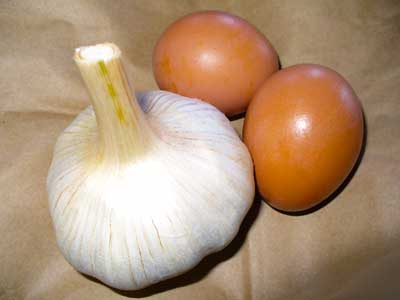Kitchen Gardens
See edible flower list below
Ever tasted a great meal and wondered what the cook’s secret was? Well, chances are they used garden fresh herbs and vegetables. Great cooks know that the right recipe is secondary to using flavorful fresh ingredients. 
Picture: A savory German Red garlic bulb waits with two delicious free range chicken eggs. Fresh food can make all the difference in a dish.
You can get vegetables from the local farmer’s market. While supporting local agriculture is great, you can’t always depend on getting the specific herbs and vegetables on the day that you want them.
In addition, most farmers markets are held weekly, so the produce that you purchased fresh on Saturday isn’t so fresh come the next Friday. To ensure that you always have the supplies for your favorite dish consider growing a kitchen garden.
Take stock of your space:
Where can you plant? Do you have a sunny window? A small backyard? Access to a community garden? A friend with space to garden who would like to share?
Kitchen gardens can be small herb gardens or larger herb and vegetable combinations. To decide what is right for you consider the space you have available and your needs. Even an apartment dweller can have a nice container garden of herbs on a sunny window. Fresh herbs can add an extra zing even to store bought vegetables. Those with a patio or balcony can add containers of their favorite vegetables. City dwellers may be able to participate in community gardens as well. If you have a small area suitable for gardening, you have even more choices. 
What do you like to eat?
As you consider your space, think about your cooking style. Do you love tomatoes? Plant extra and try several different types. Hate Brussels sprouts? Don’t waste valuable space on anything you dislike.
Some vegetables are a little overwhelming if you have only a small space. You may love sweet corn but it will be hard to fit corn stalks on a small balcony. It will be better to concentrate on plants that produce continually or quickly like herbs, peppers, cucumbers, carrots or salad greens. Some plants, like radishes or lettuce, can be planted at intervals so that you always have some ready to harvest.
Consider cute miniature plants that take up less space but are high producers. There are even miniature heirloom plants to choose from!
Do you want delectable beauty? Try edible flowers!
If you love flowers, mix them in with the edible plants. For bonus points plant edible flowers or herbs with edible flowers to use as garnishes in your dishes. Some edible flowers* that also taste good are:
- Anise Hyssop (Agastache foeniculum): tastes like sweet anise or licorice
- Basil (Ocimum basilicum): tastes like lemon, mint or similar to the plant's leaves; good dual purpose herb and flower
- Bee balm (Monarda didyma): used to make an Earl Grey tasting tea
- Borage (Borago officinalis): tastes like a mild cucumber; also herb
- Calendula, (Calendula officinalis): tastes spicy or peppery
- Chives (Allium schoenoprasum): tastes like mild onion or garlic; can be used as herb
- Cornflower (Centaurea cynaus): tastes like a sweet clove
- Fennel (Foeniculum vulgare): tastes like licorice; can eat plant
- Liliac (Syringa vulgaris): tastes floral or lemony
- Nasturtium (Tropaeolum majus): tastes slightly sweet and peppery
- Pansy (Viola X wittrockiana): tastes mildly sweet to tart
- Roses (Rosa spp. and hybrids): tastes aromatically floral and sweet
- Thyme (Thymus vulgaris): tastes like lemon; also great herb
- Violets (Viola spp.): tastes like sweet nectar
*Note: never consume something unless you are sure of the identification. You don't want to consume a poisonous plant.
What to do if you have no time to garden
Many people love the taste of home grown food but have no time to garden. The great thing about growing your garden in containers is that you can use weed free soil mixes for an almost work free growing experience.
If you have a more conventional gardening space you can add 4-5 inches of mulch around your plants or seedling to smother weeds and reduce gardening chores. To limit time spent watering, and maximize time spent cooking, add a drip irrigation line. You can even use drip or bubble irrigation with container plants. This reduces the time you spend watering and conserves water too! You may also want to try container gardens to reduce weeding.
With a small investment of time you can enjoy fresh wholesome food! Imagine the look on your friends faces when after they compliment you on a delicious meal you can tell them that you grew and cooked all the vegetables yourself!
